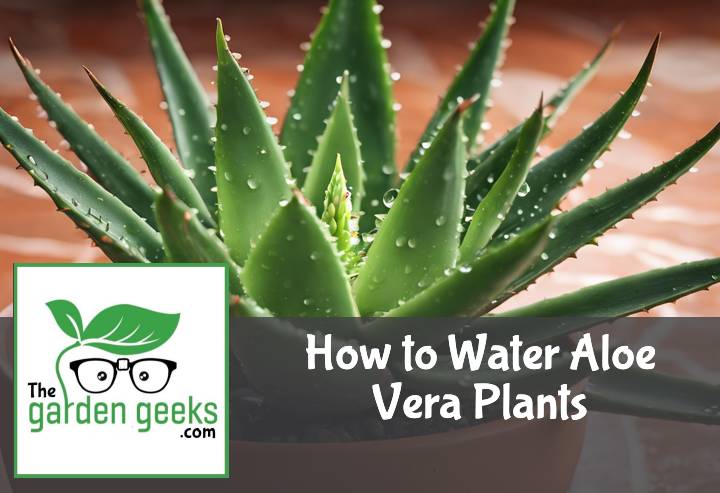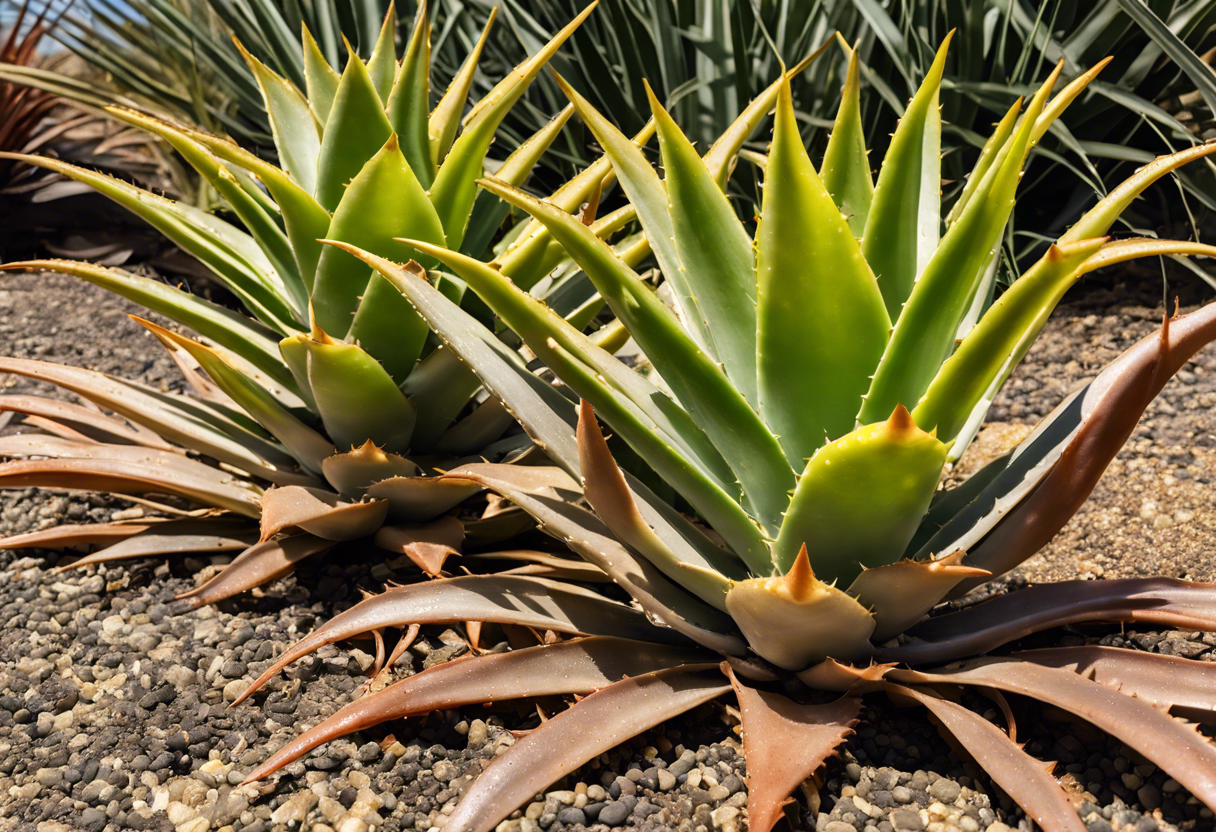Hey there, green thumbs! Ever found yourself scratching your head, wondering How to Water Aloe Vera Plants? Well, you’re not alone. These spiky green beauties are a bit of a paradox – they love the sun but don’t need much water. Sounds confusing, right? Don’t worry, we’ll demystify it together.
In this post, we’ll dive deep into the world of Aloe Vera watering. We’ll explore their unique needs and how to keep them happy and hydrated without turning them into a soggy mess. So buckle up plant lovers, it’s time to quench our thirst for knowledge! “Keep reading about How to Water Aloe Vera Plants”.
Key Takeaways
- Aloe Vera plants need watering deeply but infrequently; once every 2-3 weeks is usually sufficient.
- Overwatering can lead to root rot, a common issue with Aloe Vera.
- Water the plant more during the warmer months and less during cooler periods.
- Always allow the soil to dry completely between waterings.
- Use a well-draining soil and pot to prevent water retention.
- If leaves are thin and curled, your plant needs more water. If they’re brown and mushy, it’s overwatered.
Understanding Aloe Vera Plant’s Watering Needs
When it comes to Aloe Vera watering needs, it’s a whole different ball game. Unlike your everyday houseplants, these green buddies have their own unique set of rules.
What Makes Aloe Vera Unique in Terms of Watering?
First off, let’s talk about the unique watering needs of Aloe Vera. These plants are succulents, meaning they store water in their leaves. This makes them quite the camel of the plant world! They can go for long periods without water, thanks to this handy survival trick. So, overwatering? That’s a big no-no.
Now, onto Aloe Vera hydration. It’s not just about how much water you give them, but also when and how often. The term “succulent watering habits” might sound like some fancy botanical jargon, but it simply refers to their preference for less frequent but thorough watering sessions.
Lastly, we’ve got water absorption in Aloe Vera. These plants are pros at soaking up every last drop they get and storing it for later use. So remember folks – when you’re watering Aloe Vera, less is more!
How Does the Aloe Vera Plant’s Native Environment Influence Its Watering Needs?
Moving on to the native environment of Aloe Vera – these guys hail from arid desert regions where rainfall is scarce and sporadic. This has shaped their ability to survive with minimal water resources.
So what does this mean for your home-grown Aloe? Well, when it comes to desert plants watering needs, think infrequent but deep watering sessions that mimic desert rainfalls.
Adapting your Aloe Vera to home environment involves replicating these conditions as closely as possible. Remember folks – your bathroom isn’t a desert! Keep an eye on those watering cans and make sure you’re not turning your Aloe into a waterlogged mess.
In the end, understanding how to water Aloe Vera plants is all about appreciating their unique nature and adapting your care routine accordingly. Happy watering!
Identifying Signs of Overwatering and Underwatering
When it comes to Aloe Vera care, striking the right balance with watering is crucial. Too much or too little water can lead to some serious aloe plant health issues. Let’s dive into the telltale signs of overwatered and underwatered aloe vera plants.
What Are the Symptoms of Overwatered Aloe Vera?
Overwatering your aloe vera can cause more harm than good. The most common overwatered aloe symptoms include soggy, discolored leaves. They often turn yellow or brown due to excess moisture.
But wait, there’s more! Root rot is another nasty consequence of overwatering. It’s like a silent killer for your poor aloe plant, attacking its roots before you even notice anything’s wrong.
The last thing you want is a waterlogged aloe plant. So remember, when in doubt, less water is always better than more!
How Can You Tell If Your Aloe Vera Is Underwatered?
On the flip side, not giving your aloe enough water can also spell trouble. Underwatered aloe signs are usually quite distinct.
First off, if your plant’s leaves feel dry and brittle instead of plump and juicy, it might be crying out for some H2O love! Wilting is another red flag that your green buddy needs hydration.
And let’s not forget about those unsightly brown spots on aloes – they’re often an SOS signal from an under-hydrated plant. So next time you’re unsure about how to water Aloe Vera plants, just keep an eye out for these signs!
The Right Way to Water an Aloe Vera Plant
Knowing how to water Aloe Vera plants is crucial for their survival. It’s not just about pouring some H2O, but understanding the plant’s hydration needs. This involves timing, quantity, and type of water. So let’s dive into the nitty-gritty of Aloe Vera plant care.
When Should You Water Your Aloe Vera Plant?
Watering your Aloe Vera isn’t a daily chore. These plants are desert dwellers, so they’re used to dry spells. In fact, they prefer it! Now, you might be wondering about the best time to water Aloe Vera.
Well, it depends on a few factors like climate and season. If you’re in a hot area or during summer months, your plant will need more frequent watering – maybe once a week. But in cooler climates or winter season? You can cut back to once every two weeks or even less.
Remember this golden rule: when in doubt, wait it out! Overwatering is far worse than underwatering for these hardy little guys.
How Much Water Does an Aloe Vera Plant Need?
Now that we’ve sorted out the timing let’s talk about quantity. Just how much water does this succulent need? Well, here’s where things get interesting.
Aloes love a good soak but hate sitting in water. So when you do water them, make sure you drench the soil thoroughly. Let the water run through the drainage holes at the bottom of your pot – this ensures all parts of the root system get hydrated.
But remember – no puddles! If there’s still water in the saucer after 15 minutes, dump it out to prevent root rot and keep your plant happy and healthy!
What Type of Water is Best for Aloe Vera Plants?
Last but not least – what type of water should you use? Tap water, distilled, rainwater – what’s the best water type for Aloe Vera?
Well, most Aloe Veras aren’t picky. They’ll happily slurp up tap water. But if your tap water is hard or has a high mineral content, it might cause salt build-up in the soil over time.
In this case, using distilled or rainwater can be a better option. It helps maintain a healthy soil environment and keeps your Aloe Vera plant thriving! So there you have it – the lowdown on watering these spiky green friends. Happy watering!
Factors Influencing the Frequency and Amount of Watering
When it comes to how to water Aloe Vera plants, several factors can influence your watering schedule. These include the size and type of pot, seasonal changes, and whether your plant is indoors or outdoors. So let’s dive in!
How Does Pot Size and Type Impact Watering Frequency?
The pot size and type play a significant role in determining the watering frequency based on pot size. For instance, Aloe Vera in small pots tends to dry out faster than those in larger ones. Therefore, they might need more frequent watering.
On the other hand, large pot aloe vera care requires less frequent watering as the soil retains moisture for longer periods. The material of the pot also matters. Ceramic vs plastic pots for aloe vera can make a difference as ceramic pots are porous and allow water to evaporate quicker than plastic ones.
How Do Seasonal Changes Impact the Watering Schedule?
Seasonal changes can significantly affect your Aloe Vera watering frequency. During summer months, when temperatures are high, you might need to follow a more regular summer aloe vera watering schedule due to increased evaporation.
However, during winter months, your plant’s water needs decrease drastically. This is because cooler temperatures slow down evaporation rates. So remember: when it comes to winter care for aloe vera plants, less is more!
How Does Indoor vs Outdoor Location Influence Watering Needs?
Whether your Aloe Vera plant is located indoors or outdoors can also impact its watering needs. Generally speaking, indoor plants tend to require less water than outdoor ones due to lower light levels and humidity.
In contrast, outdoor plants are exposed to elements like wind and sun which can cause them to dry out faster – hence requiring more frequent watering. However, every plant is unique! So always keep an eye on your Aloe Vera and adjust its watering schedule as needed.
Troubleshooting Common Problems Related to Watering
Hey, plant parent! Ever wondered why your aloe vera is throwing a tantrum despite all the TLC you’re giving it? Well, aloe vera watering problems can be tricky. You see, overwatering aloe vera and underwatering aloe vera are common aloe vera care mistakes. But don’t worry! We’re here to help you with some troubleshooting.
Why Is My Aloe Vera Turning Brown or Yellow Despite Regular Watering?
So, your aloe’s leaves are turning into autumn colors in the middle of spring? That’s not right! Here’s the thing: regular watering doesn’t always mean healthy plants. If your aloe vera is turning brown or you’ve got some yellow aloe leaves, it could be due to poor water quality or root health issues. Yes, even plants can have bad hair days (or should we say root days?). An overwatered plant might suffer from root rot in aloes, while tap water full of chemicals can affect the overall health of your green buddy.
Why Are My Aloe Leaves Becoming Thin and Curled, Even with Adequate Water?
Now this one’s another head-scratcher. Curling and thinning leaves on an otherwise well-watered aloe? It sounds like your plant might be having temperature tantrums or nutrient niggles. Sudden changes in temperature can lead to those pesky curling aloe leaves, while nutrient deficiencies could cause thinning. So remember folks, when it comes to learning how to water Aloe Vera plants, it’s not just about H2O – temperature and nutrients play their parts too!
To Wrap Up
Just like Goldilocks, aloe vera plants don’t want their water too hot or too cold – they want it just right. We’ve covered the ins and outs of How to Water Aloe Vera Plants, so you’re now armed with the knowledge to keep your succulent buddy happy and hydrated.
Remember, overwatering is like giving your plant a soggy bottomed pie – no one likes that! So go forth, water wisely and let your aloe vera thrive.





